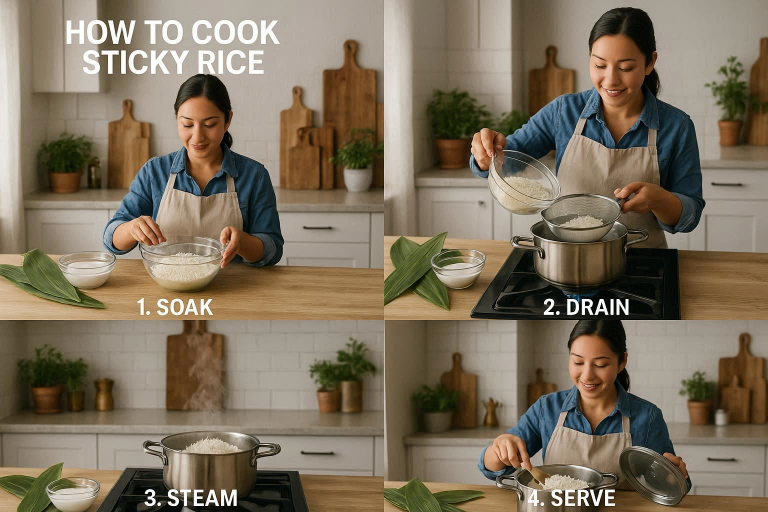Sticky rice, also known as glutinous rice or sweet rice, is an essential ingredient in many Southeast Asian dishes, offering a unique texture and flavor. Its ability to absorb moisture and flavors makes it a perfect side dish or base for many traditional recipes. Whether you’re preparing Thai mango sticky rice, sushi, or pairing it with grilled meats, getting the cooking process just right is key to achieving that perfect sticky, chewy texture.
In this guide, we’ll explore the essential steps for cooking sticky rice to perfection every time, including soaking, steaming, and even using a rice cooker or stovetop methods. We’ll also cover how to enhance the flavor with sweet and savory options and provide solutions to common sticky rice mistakes.
What is Sticky Rice?
Sticky rice, also called glutinous rice or sweet rice, is a unique type of rice that’s different from regular white rice. Its defining feature is its sticky, chewy texture, which comes from the high starch content—particularly a starch called amylopectin. This rice is commonly used in many Asian cuisines, especially in Thailand, Laos, and other Southeast Asian countries.
Unique Characteristics of Sticky Rice
Unlike regular rice, sticky rice has minimal amylose, which results in its unique ability to stick together and become chewy once cooked. It’s not typically Mastering Everyday Cooking used for fluffy dishes; instead, it’s favored for its ability to hold together, making it ideal for serving with curries, stews, or using it as a base for desserts.
Sticky rice’s versatility also extends to its ability to absorb the flavors of whatever it’s paired with, making it perfect for savory and sweet dishes alike. Whether you’re making sushi, mango sticky rice, or accompanying grilled meats, the perfect sticky rice elevates the overall meal experience.
Common Uses in Southeast Asian Cuisines
Sticky rice is an integral part of various dishes. In Thailand, it is traditionally served with grilled meats, seafood, or the famous mango sticky rice. In Laos, sticky rice is often paired with spicy dipping sauces and grilled meats. Sticky rice is also used to make rice cakes, rice balls, and even desserts like khao niew mamuang (mango sticky rice).
Why It’s Important to Cook Sticky Rice Properly
Cooking sticky rice perfectly every time is essential for achieving its unique texture and flavor. The key is getting the rice to be soft, sticky, and chewy—without being too mushy or dry. When cooked correctly, sticky rice should be tender and sticky, yet able to hold its shape. Proper cooking not only improves the texture but also helps the rice absorb the flavors it is paired with, ensuring a balanced and delicious meal.
Understanding Sticky Rice
What Makes Sticky Rice Different?
Sticky rice’s key differentiator from regular rice is its starch content. Unlike other types of rice, sticky rice is almost entirely composed of amylopectin, which makes it sticky when cooked. Regular rice, in contrast, contains both amylopectin and amylose, resulting in a firmer and less sticky texture.
Sticky rice’s ability to absorb moisture and flavor during cooking makes it a popular choice in savory and sweet dishes. Whether you’re using it in sushi or a Thai curry, sticky rice pairs beautifully with both complex flavors and light accompaniments.
Types of Sticky Rice
- White Sticky Rice: The most commonly used sticky rice, perfect for traditional dishes like mango sticky rice or serving with grilled meats and curry.
- Brown Sticky Rice: A healthier alternative, with a chewier texture and more nutrients. It’s also higher in fiber than white sticky rice.
- Black Sticky Rice: Typically used in desserts, this rice has a rich, nutty flavor and a striking color. It’s often paired with coconut milk for a delicious dessert.
Why Sticky Rice is Popular in Asian Cuisine
Sticky rice has deep cultural and historical roots in many Southeast Asian countries. It is considered a staple food, especially in Thailand and Laos. Historically, sticky rice was used as a form of currency, and today, it’s served at nearly every meal—whether as a side dish or a main component. Its ability to pair perfectly with spicy, salty, or sweet dishes makes it a versatile choice for various cuisines.
Preparing Sticky Rice for Cooking
Choosing the Right Sticky Rice
When buying sticky rice, always look for glutinous rice (not to be confused with regular white rice). Choose a variety that is plump and glossy, not dry or broken. High-quality sticky rice will cook evenly and produce the right texture.
You can purchase sticky rice from most Asian grocery stores or online retailers. Be sure to check if it’s labeled “glutinous rice” or “sweet rice” to ensure it’s the right variety.
Soaking Sticky Rice: The Key to Perfect Texture
One of the most important steps in cooking sticky rice is soaking it. Soaking softens the rice and ensures that it cooks evenly, giving it that characteristic chewy texture.
- Recommended Soaking Time: Soak sticky rice for 4-6 hours, or overnight if you have time. Soaking helps to rehydrate the rice and makes it easier to cook.
- Can You Skip Soaking? While it’s possible to cook sticky rice without soaking it, the texture will not be as ideal. Skipping soaking can result in rice that’s either too firm or overly sticky.
Rinsing Sticky Rice
Rinsing sticky rice is another key step in ensuring perfect rice. Rinsing removes excess starch and prevents the rice from becoming overly sticky.
- How to Rinse: Place sticky rice in a large bowl and rinse with cold water. Gently stir the rice and drain the water. Repeat until the water runs clear.
How to Cook Sticky Rice to Perfection
Step 1: Steaming Sticky Rice – The Traditional Method
The traditional and best method for cooking sticky rice is steaming. Steaming ensures that the rice retains its characteristic stickiness and chewy texture, without being too soft or mushy.
- Using a Steamer: You can use a bamboo steamer or a metal mesh steamer basket. The rice is placed in the basket over a pot of boiling water, where it’s steamed for about 20-30 minutes.
- Steaming Tips: Cover the sticky rice with a clean cloth to prevent water droplets from falling onto the rice. Steam in batches if you have a large amount to cook, as overcrowding can lead to uneven cooking.
Step 2: Cooking Sticky Rice with a Rice Cooker
While traditional steaming gives the best results, a rice cooker is a convenient alternative for cooking sticky rice.
- Rice Cooker Settings: Use the sticky rice setting or the “white rice” function. Make sure to adjust the water-to-rice ratio for sticky rice (usually 1:1 or slightly less water).
- How to Cook: Once the rice is in the cooker, set it to cook and check it halfway through to ensure it’s steaming evenly.
Step 3: Cooking Sticky Rice on the Stovetop
Cooking sticky rice on the stovetop is also possible if you don’t have a rice cooker or steamer.
- Water-to-Rice Ratio: Use about 1 cup of water for every cup of sticky rice. Bring the water to a boil, then reduce heat to low, cover the pot with a lid, and cook for 15-20 minutes.
- How to Prevent Overcooking or Burning: To trap steam, place a towel under the lid before covering the pot. This helps keep the rice moist and prevents burning at the bottom.
Enhancing the Flavor of Sticky Rice
Sweet Sticky Rice for Desserts
To make sweet sticky rice, especially for Thai dishes like mango sticky rice, add coconut milk, sugar, and a pinch of salt to the cooked rice. The coconut milk adds richness and creaminess, while the sugar brings sweetness.
- How to Serve: Top the sweet sticky rice with fresh mango slices for an authentic dessert experience.
Savory Sticky Rice for Meals
Sticky rice can also be served as a savory dish by infusing it with herbs, spices, or broth during cooking. For example, adding ginger, lemongrass, or garlic can elevate the flavor of sticky rice and complement grilled meats or curries.
- Serving Suggestions: Serve savory sticky rice alongside grilled chicken, pork, or seafood. You can also mix in vegetables for a healthy, savory meal.
Common Mistakes to Avoid When Cooking Sticky Rice
Not Soaking Enough
Not soaking sticky rice for the recommended time can result in a hard, undercooked texture. Always ensure you soak your sticky rice for at least 4 hours, or overnight if you can.
Overcooking or Undercooking Sticky Rice
Sticky rice that is overcooked will become mushy and lose its chewy texture, while undercooked rice will remain hard. Make sure to monitor your cooking times and check the texture of the rice.
Using the Wrong Cooking Method
While steaming is the most traditional and effective method for cooking sticky rice, using a rice cooker or stovetop can work in a pinch. Just make sure to adjust the water levels and cooking time accordingly.
Tips for Perfect Sticky Rice Every Time
Resting After Cooking
Let the sticky rice rest for a few minutes after cooking to help it set and become more sticky. This step allows the grains to stick together while keeping their tender texture.
Keep Sticky Rice Warm
Sticky rice should be kept warm and moist after cooking. Use a damp cloth to cover the rice or place it in a rice cooker’s “keep warm” mode.
Storing Leftover Sticky Rice
Store any leftover sticky rice in an airtight container in the fridge. To reheat, steam it again or microwave it with a little water to prevent it from drying out.
FAQ Section
- How long should I soak sticky rice before cooking?
- Soak sticky rice for 4-6 hours, or overnight for best results.
- Can I cook sticky rice in a regular rice cooker?
- Yes, use the sticky rice function or adjust the water-to-rice ratio for best results.
- Why is my sticky rice too hard or dry?
- It could be due to insufficient soaking, incorrect water ratios, or overcooking.
- Can I use a regular pot to cook sticky rice?
- Yes, but the texture may not be as ideal as steaming.
- How do I know when sticky rice is done?
- The rice should be tender and sticky but still hold its shape.
- Can I make sweet sticky rice without coconut milk?
- Yes, you can use sugar and a pinch of salt for flavor.
Conclusion
Cooking sticky rice to perfection every time comes down to the right preparation, soaking, and cooking methods. Whether you’re steaming, using a rice cooker, or cooking on the stovetop, following these steps will ensure that your sticky rice turns out soft, sticky, and delicious. Experiment with savory and sweet variations to complement your favorite dishes, and don’t forget to serve it alongside grilled meats, curries, or tropical fruits. Now that you know the secrets to perfect sticky rice, it’s time to start cooking and enjoy the perfect texture and flavor in every bite!

